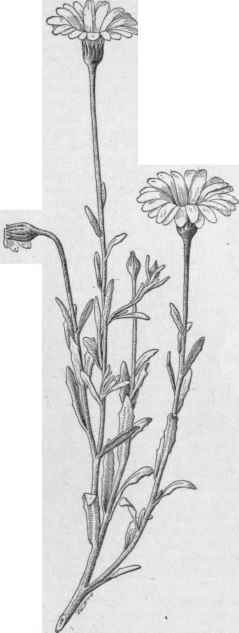Diokaea
Description
This section is from the book "The Standard Cyclopedia Of Horticulture Vol2", by L. H. Bailey. See also: Western Garden Book: More than 8,000 Plants - The Right Plants for Your Climate - Tips from Western Garden Experts.
Diokaea
(Greek name for Venus). Droserdceae. Vends Fly-trap. A remarkable monotypic genus of insectivorous plants, often grown for curiosity and in botanical collections.
Leaves 1-5 in. long, 4-8 in number, are arranged in a spreading rosette over the soil, each consisting of a flat expanded petiole, and terminal bilobed blade; midrib of the blade contractile, the margins prolonged into bristles that interlock when the halves close, while each half bears 3 jointed and highly irritable hairs arranged in triangular manner over its upper surface; abundant sessile glands, usually of a crimson color, cover this surface and render it attractive to insects; but when grown in shade the glands and therefore the leaves are quite green: a single neat touch of a hair fails to cause closure, but when one of the hairs is touched twice, or when two adjacent hairs are touched once within a short interval apart, the halves close. Owing to continued and repeated stimuli caused by a caught insect, or to chemical stimuli caused by its tissues, the glands exude an acid and peptonizing digestive fluid after a few hours; this starts digestive disintegration of the insect's tissues, and the dissolved products are then absorbed by the If . - halves: the flower -stalk lengthens in May to 8-10 in. and bears 4-10 white flowers which expand in June, and which must be cross-pollinated for seed-production. By the end of June the caps, burst, and expose small black shining seeds.
These germinate in abundance under a bell-jar on moist sandy soil that is mixed with finely chopped sphagnum moss. Each seedling, after forming 2 lanceolate cotyledons, produces thereafter tiny fly-trapping leaves that behave like the adult ones. Plants thrive well when grown in 3-5-in. pots amid a mixture of fine silver-sand and black silt. The pots should be kept immersed for about an inch in water, should have a slight top-covering of sphagnum, and must be kept near the glass in a greenhouse with southeastern exposure. Inhabits the edges of moist sandy savannah "bottom" lands, is found wild over a narrow strip of territory about 10 miles in width and 40 miles north, also to an equal distance south of Wilmington, N. C, and grows well only when the tips of its roots reach a moist substratum, and when active transpiration proceeds. The perennial underground part is a bulbous swelling that can readily be dug and distributed from Nov. to March. It is seldom that this wonderful little plant is seen in a good state of cultivation any length of time after removal from its native haunts. Its cultivation in a greenhouse is usually attended with more or less difficulty, owing to unsuitable conditions, such as too much dry air, shade or unfriendly soil.
It delights in full sunshine, with a very humid atmosphere. When the plants can be secured and transplanted with considerable of the soil in which they grow attached to the bulb-like rootstalks, they are quite easily dealt with, and may be kept in a healthy growing state for years. I find a round hanging earthenware receptacle most useful to grow them in; the bottom is carefully drained, first with large pieces of broken pots, then smaller pieces, and the upper layer is quite fine. Some chopped fibrous peat is placed above this, when the plants are built in with live sphagnum moss used to fill the spaces between the clumps. Arranged in this way, it is hardly possible to give them too much water, and they revel in abundant supplies. If kept in the sun the leaves take on a reddish tinge, but when grown in the shade they are always green. Flowers will develop about the middle of June, but they should be nipped off as they make their appearance, for they are apt to weaken the plant. - The dionaea has been grown successfully in a dwelling-house by a very different method. The plants were in a wide, shallow dish, without any drainage, and simply placed, not too firmly, in loose live sphagnum moss, with a glass covering.
Water was given every other day by filling the space above the plants until the dish was filled, and then it was poured off. In this way the potting material never became sour. From the luxuriant condition in which these plants remained for years, I am inclined to think this was a close imitation of the conditions under which they thrive in a wild state. Some years ago, owing to Asa Gray's endeavor to have the Government purchase a strip of land on which this plant grows, there existed a widespread idea that it was gradually becoming extinct. There seems to be little likelihood of this calamity, however, as Dionaea is found abundantly in some places. (G. W. Oliver, in Garden and Forest, 10:237 [1897]).

Fig. 1267. Dimorphotheca aurantiaca, one of the best of recent flower-garden acquisitions. (X 1/3)

Fig. 1268. The Venus' Fly-trap- Dionaea muscipula.
Muscipula
Ellis. Fig. 1268. stem short, subterranean, coated by the swollen bases of leaves: leaves 1-5 in. long in radial rosette, divided into winged petiole and bilobed lamina: infloresence umbellate; flowers 3/4-1 in.; petals white; stamens usually 15; pistil of 5 united carpels, stigmas 5 penicillate: fruit a caps. B.M. 785. F.S. 3:280. Mn. 1, p. 69. j. M. Macfarlane.
Continue to:


